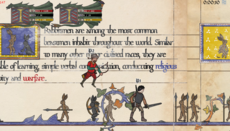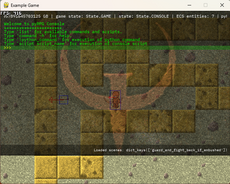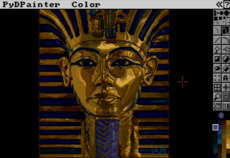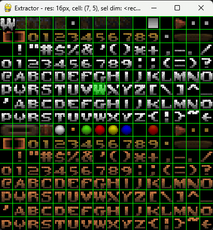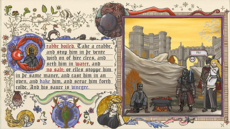CairoPygame — wiki
This piece of code allows you to convert a Cairo surface to a PyGame surface. It also includes a small example on how to make SVG loading work. It works with Python 2.5+ and requires relatively recent versions of pygame, pycairo and NumPy to work. For the SVG example to work, you must also have rsvg installed.
#!/usr/bin/env python
# Copyleft 2010 Niels Serup, WTFPL 2.0. Free software.
### Imports ###
import math
import pygame
import cairo
import numpy
import Image
### Constants ###
width, height = 640, 480
### Functions ###
def draw(ctx):
ctx.set_line_width(15)
ctx.arc(320, 240, 200, 0, 2 * math.pi)
# r g b a
ctx.set_source_rgba(0.6, 0, 0.4, 1)
ctx.fill_preserve()
# r g b a
ctx.set_source_rgba(0, 0.84, 0.2, 0.5)
ctx.stroke()
def bgra_surf_to_rgba_string(cairo_surface):
# We use PIL to do this
img = Image.frombuffer(
'RGBA', (cairo_surface.get_width(),
cairo_surface.get_height()),
cairo_surface.get_data(), 'raw', 'BGRA', 0, 1)
return img.tostring('raw', 'RGBA', 0, 1)
### Body ###
# Init PyGame
pygame.display.init()
screen = pygame.display.set_mode((width, height), 0, 32)
# Create raw surface data (could also be done with something else than
# NumPy)
data = numpy.empty(width * height * 4, dtype=numpy.int8)
# Create Cairo surface
cairo_surface = cairo.ImageSurface.create_for_data(
data, cairo.FORMAT_ARGB32, width, height, width * 4)
# Draw with Cairo on the surface
ctx = cairo.Context(cairo_surface)
draw(ctx)
##### SVG LOADING EXAMPLE #####
# Using rsvg it is possible to render an SVG file onto a Cairo
# surface. Uncomment the following lines to make it work.
#import rsvg # This will probably not work in Windows. As far as I
# know, only GNU/Linux distibutions package this Python
# module. Nevertheless, it should be easy to create a small wrapper;
# see http://www.cairographics.org/cairo_rsvg_and_python_in_windows/
# Load the file
#svg_graphics = rsvg.Handle('path/to/file.svg')
# Render the graphics onto your Cairo context
#svg_graphics.render_cairo(ctx)
# To get the SVG file's dimensions before you create a Cairo surface,
# use the following function:
#print svg_graphics.get_dimension_data()
###############################
# On little-endian machines (and perhaps big-endian, who knows?),
# Cairo's ARGB format becomes a BGRA format. PyGame does not accept
# BGRA, but it does accept RGBA, which is why we have to convert the
# surface data. You can check what endian-type you have by printing
# out sys.byteorder
data_string = bgra_surf_to_rgba_string(cairo_surface)
# Create PyGame surface
pygame_surface = pygame.image.frombuffer(
data_string, (width, height), 'RGBA')
# Show PyGame surface
screen.blit(pygame_surface, (0,0))
pygame.display.flip()
clock = pygame.time.Clock()
while not pygame.QUIT in [e.type for e in pygame.event.get()]:
clock.tick(30)
#!/usr/bin/env python
import cairo
import pygame
import math
size = 400, 400
# Initialize pygame with 32-bit colors. This setting stores the pixels
# in the format 0x00rrggbb.
pygame.init()
screen = pygame.display.set_mode(size, 0, 32)
# Get a reference to the memory block storing the pixel data.
pixels = pygame.surfarray.pixels2d(screen)
# Set up a Cairo surface using the same memory block and the same pixel
# format (Cairo's RGB24 format means that the pixels are stored as
# 0x00rrggbb; i.e. only 24 bits are used and the upper 16 are 0).
cairo_surface = cairo.ImageSurface.create_for_data(
pixels.data, cairo.FORMAT_RGB24, size[0], size[1])
# Draw a white circle to the screen using pygame.
radius = int(min(size)/2*0.7)
pos = [int(a/2) for a in size]
pygame.draw.circle(screen, (255,255,255), pos, radius)
# Draw a smaller black circle to the screen using Cairo.
context = cairo.Context(cairo_surface)
context.set_source_rgb(0, 0, 0)
context.arc(size[0]/2, size[1]/2, min(size)/2*0.5, 0, 2*math.pi)
context.fill()
# Flip the changes into view.
pygame.display.flip()
# Wait for the user to quit.
while pygame.QUIT not in [e.type for e in pygame.event.get()]:
pass
#!/usr/bin/env python
import cairo
import pygame
import array
import math
import sys
def draw(surface):
x,y, radius = (250,250, 200)
ctx = cairo.Context(surface)
ctx.set_line_width(15)
ctx.arc(x, y, radius, 0, 2.0 * math.pi)
ctx.set_source_rgb(0.8, 0.8, 0.8)
ctx.fill_preserve()
ctx.set_source_rgb(1, 1, 1)
ctx.stroke()
def input(events):
for event in events:
if event.type == pygame.QUIT:
sys.exit(0)
else:
print event
#Create Cairo Surface
Width, Height = 512, 512
data = array.array('c', chr(0) * Width * Height * 4)
stride = Width * 4
surface = cairo.ImageSurface.create_for_data (data, cairo.FORMAT_ARGB32,Width, Height, stride)
#init PyGame
pygame.init()
window = pygame.display.set_mode( (Width,Height) )
screen = pygame.display.get_surface()
#Draw with Cairo
draw(surface)
#Create PyGame surface from Cairo Surface
image = pygame.image.frombuffer(data.tostring(),(Width,Height),"ARGB",)
#Tranfer to Screen
screen.blit(image, (0,0))
pygame.display.flip()
while True:
input(pygame.event.get())
#!/usr/bin/env python
import cairo
w, h = 128, 128
# Setup Cairo
surface = cairo.ImageSurface(cairo.FORMAT_ARGB32, w, h)
ctx = cairo.Context(surface)
# Set thickness of brush
ctx.set_line_width(15)
# Draw out the triangle using absolute coordinates
ctx.move_to(w/2, h/3)
ctx.line_to(2*w/3, 2*h/3)
ctx.rel_line_to(-1*w/3, 0)
ctx.close_path()
# Apply the ink
ctx.stroke()
# Output a PNG file
surface.write_to_png("triangle.png")
# Alias the image as a numpy array
import numpy
# This needs better than pycairo-1.2.2, eg. pycairo CVS:
# cvs -d :pserver:anoncvs@cvs.freedesktop.org:/cvs/cairo co pycairo
buf = surface.get_data()
a = numpy.frombuffer(buf, numpy.uint8)
a.shape = (w, h, 4)
a[:,:,2] = 255
surface.write_to_png("triangle1.png") # red triangle..
# Alias the image as a pygame surface
import pygame
from time import sleep
imsurf = pygame.image.frombuffer(buf, (w,h), "RGBA")
depth = 4*8
pygame.display.init()
surface = pygame.display.set_mode((w,h), pygame.DOUBLEBUF, depth)
done = False
while not done:
surface.blit(imsurf, (0,0)) # blue triangle..
sleep(0.1)
events = pygame.event.get()
for event in events:
if event.type == pygame.QUIT:
done = True
pygame.display.flip()
#!/usr/bin/env python
import cairo
w, h = 128, 128
# Setup Cairo
surface = cairo.ImageSurface(cairo.FORMAT_ARGB32, w, h)
ctx = cairo.Context(surface)
# Set thickness of brush
ctx.set_line_width(15)
# Draw out the triangle using absolute coordinates
ctx.move_to(w/2, h/3)
ctx.line_to(2*w/3, 2*h/3)
ctx.rel_line_to(-1*w/3, 0)
ctx.close_path()
# Apply the ink
ctx.stroke()
#!/usr/bin/env python
import sys, cStringIO, pygame, pygame.locals
pygame.init()
f = cStringIO.StringIO()
surface.write_to_png(f)
screen = pygame.display.set_mode((w, h))
screen.fill((255, 255, 255))
f.seek(0)
pic = pygame.image.load(f,'temp.png').convert_alpha()
screen.blit(pic, (0, 0))
pygame.display.flip()
clock = pygame.time.Clock()
while True:
clock.tick(15)
for event in pygame.event.get():
if event.type == pygame.locals.QUIT:
raise SystemExit


